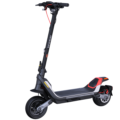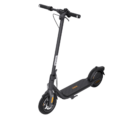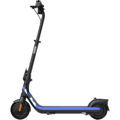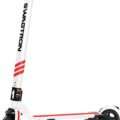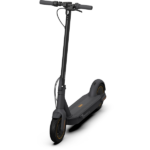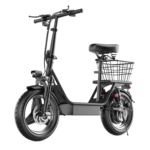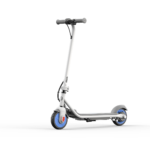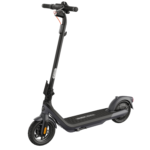- Home
- Scooters
- Electric Scooters
- Segway Ninebot C2
Segway Ninebot C2


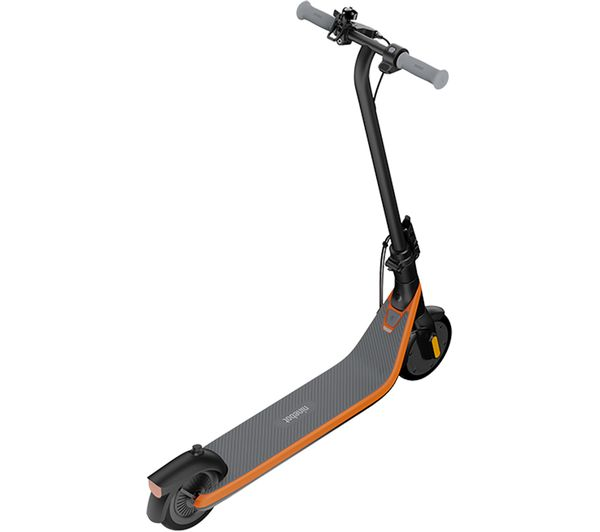
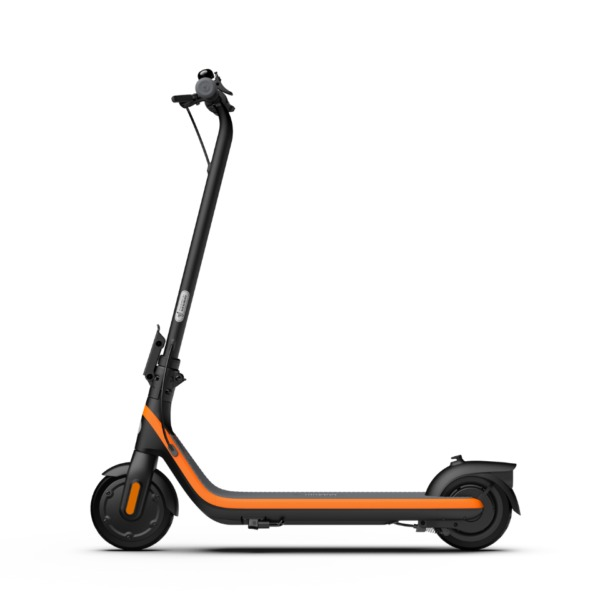
- Battery Range: 11 km (6.8 mi)
- Top Speed: 16 km/h (10 mph)
- Motor Power: 130 W nominal
- Weight Capacity: 50 kg (110 lb)
- Charging Time: 3.5 h
- Scooter Weight & Portability: 10.4 kg (22.9 lb)
PROS
- Kid-friendly 16 km/h cap
- Rear drum brake with smooth feel
- 7-inch hollow tyres (no tubes)
- RGB under-deck ambient lights
- Easy fold for storage and transport
- IPX4 body / IPX6 battery enclosure
CONS
- Short range for long park days
- No front brake
- No app connectivity
- Not for rough surfaces
- No suspension


Overview: A Safe, Fun Starter Scooter for Kids
The Segway Ninebot C2 is a kids’ eKickScooter designed to make first rides feel safe, simple, and genuinely fun. It focuses on three essentials that matter to families: easy control, clear visibility, and low maintenance. Because it caps speed at up to 16 km/h, delivers up to 11 km of range, and rolls on 7-inch inner-hollow tyres that never need tubes, the C2 gives young riders a forgiving platform for learning. Meanwhile, a rear drum brake offers predictable lever feel, and bright RGB under-deck lights boost both visibility and excitement. Since the lightweight frame folds quickly, the scooter stores neatly at home and travels easily in a car boot.
Under the deck, a brushless 130 W motor provides smooth launches that help new riders build confidence without sudden surges. The compact deck encourages a stable stance, and the friendly overall weight keeps handling comfortable at neighbourhood speeds. Parents will also appreciate the IPX4 body and IPX6 battery enclosure, which provide basic splash protection for light rain—useful for school runs and weekend park loops when weather shifts unexpectedly.
Because the C2 includes three riding modes—Standard, Sport, and Power-assist—it adapts gracefully as skills grow. Charging is straightforward at about 3.5 hours from near empty. For best battery health, it’s smart to store the scooter indoors around half charge when pausing riding for several weeks. Overall, the C2 balances safety and fun for riders aged roughly 6–12, making short school hops and weekend loops easy, engaging, and repeatable.
Who the Segway Ninebot C2 Is For
The C2 is built for families who want an approachable, kid-friendly electric scooter that evolves with a child’s confidence. It’s an excellent choice for:
- New riders who need gentle power and a low, stable deck.
- School-age kids who ride supervised routes around parks, cul-de-sacs, and bike paths.
- Parents who prefer predictable brakes, puncture-resistant tyres, and simple care routines.
- Households with limited storage, because the fold makes the C2 easy to tuck away.
Crucially, the C2 prioritizes control over raw speed. Many youth scooters either feel too sluggish to be fun or too punchy to be safe. The C2 threads the needle: it’s lively enough to feel exciting, yet measured enough to keep learning calm and positive.
Design Philosophy: Confidence First, Then Fun
Everything about the C2’s design helps a young rider feel stable from the first push. The deck height is low and inviting, so kids can step on and off without awkward hops. The handlebar width supports a comfortable shoulder stance, which improves balance and steering control. Additionally, the control layout is intentionally simple—just the throttle, a brake lever, and a clear display—so attention stays on the path ahead, not on buttons.
Style matters to kids, and the C2 leans into that with RGB under-deck lighting. This feature isn’t just for flair; it helps other path users see the scooter from the side and at dusk. Because safety and fun reinforce each other here, the C2 turns “being visible” into something riders actually enjoy.
Motor and Throttle: Smooth Power for Learning
At the heart of the C2 is a 130 W brushless motor. Numbers aside, what matters most is the feel. Power ramps up smoothly rather than snapping on, which reduces wobble and keeps hands relaxed on the grips. As a result, first accelerations feel controlled, not scary. On gentle inclines and smooth park paths, the scooter maintains a steady pace without demanding constant throttle corrections.
The throttle throw is kid-friendly, too. It provides enough travel for small adjustments, which teaches riders how slight inputs change speed. Because the C2’s top speed is capped at up to 16 km/h, kids can explore pace safely while staying within a sensible limit.
Three Riding Modes: Skills That Grow Step by Step
Learning sticks when progress is gradual. The C2’s three modes create a clear ladder:
- Power-assist: Minimal motor output. Kids push off and feel a gentle electric nudge. This mode builds balance and steering fundamentals without overwhelming speed.
- Standard: A balanced profile with modest acceleration and a comfortable cruising pace. It’s ideal for most practice sessions on smooth, open paths.
- Sport: The most responsive mapping within the 16 km/h cap. As skills mature, Sport keeps rides engaging while preserving safe limits.
Because mode changes are simple, parents can start cautious and, over time, step up as their child demonstrates consistent control, attention, and good braking habits.
Braking You Can Trust: Rear Drum + Predictable Feel
The C2 uses a rear drum brake, a smart choice for a kids’ scooter. Drums are enclosed, so they resist dust and light splashes better than exposed calipers. More importantly, they deliver a smooth, progressive lever feel that kids can understand. Instead of a sudden bite, the brake builds force as the lever moves, teaching the valuable lesson of modulation.
To reinforce safe stopping, practice short “brake drills” at the start of every ride: roll to a gentle pace, then apply steady lever pressure and come to a smooth stop. Because kids love repetition, turning it into a mini-game (“three perfect stops before we go!”) builds a habit that lasts.
Tyres and Ride Quality: Inner-Hollow, Puncture-Resistant
Punctures ruin park days. The C2’s 7-inch inner-hollow tyres help eliminate that frustration. Instead of fragile tubes, the tyres use a hollow structure that absorbs small bumps and avoids pinch flats. While they don’t replace the plushness of large pneumatic tyres, they do reduce maintenance while still filtering common cracks and seams.
Because the tyres are smaller than adult models, teach kids to scan the path and roll straight over small obstacles at a sensible pace rather than turning sharply at the last second. This habit protects stability and prevents “over-steer” wobbles.
Visibility and Fun: RGB Lights That Do Real Work
The under-deck RGB lighting does more than sparkle. Side visibility is one of the biggest safety upgrades for small riders, especially at dusk when silhouettes are hard to judge. With the C2, other path users can see motion and position more easily. Meanwhile, the colours keep kids engaged. They learn that being seen is part of riding well—without any nagging required.
Add a CPSC/EN-certified helmet, bright clothing, and a small reflective patch on the backpack, and you’ve layered in simple visibility gains that matter at kid speeds.
Weather Readiness: Splash Protection with Sensible Limits
Life doesn’t stop for a sprinkle. The C2’s IPX4 body and IPX6 battery enclosure provide basic splash resistance for light rain. Practically, that means you can finish a short ride if weather shifts. However, you still avoid heavy downpours, deep puddles, power-washing, and extended exposure to wet conditions. After any damp session, wipe the scooter dry, especially around the brake, deck, and any ports. Because light care pays off, this quick routine protects both performance and appearance.
Battery and Charging: Simple, Predictable Routines
Battery anxiety shouldn’t exist on a kids’ scooter. With up to 11 km of range in favourable conditions, the C2 easily covers short school hops and park loops. Better yet, charging from near empty takes about 3.5 hours, which fits neatly into an afternoon or evening.
Parent-friendly battery tips:
- Top up before outings, not after bedtime, so kids start with a full, ready scooter.
- Avoid deep discharges daily; staying above ~20% supports long-term health.
- Store around 40–60% if pausing rides for several weeks.
- Keep the scooter indoors at moderate temperatures to protect the pack.
Because the goal is simple predictability, these habits keep range consistent and the scooter ready.
Fit and Ergonomics: Small Changes, Big Confidence
Comfort fuels control. The C2’s deck offers enough space for a staggered stance—front foot angled, rear foot slightly offset. This stance squares the hips, steadies the torso, and reduces arm tension. Show kids how small knee bends act like shock absorbers; it’s a fun way to explain balance.
If the handlebar height is adjustable in your market version, set it near the mid-chest level of the rider when standing tall in shoes. Too low invites slouching; too high makes steering heavy. A quick check every growth spurt keeps handling friendly.
Teaching Plan: A Week-by-Week Progression
Week 1 – Fundamentals (Power-assist):
Start on a flat, empty surface. Practice mounting, pushing off, coasting, and gentle, straight-line braking. Keep sessions short and celebratory.
Week 2 – Steering and Smoothness (Standard):
Add wide, gentle S-turns and consistent cruising. Teach head-up scanning: eyes look where you want to go. Introduce “predictable path” riding—no sudden swerves.
Week 3 – Real Routes and Rules (Standard → Sport):
Move to quiet paths. Practice signalling intent with body language, riding single-file, and yielding politely. If control is solid, introduce Sport in short bursts on clear stretches.
Week 4 – Routines and Responsibility:
Make pre-ride checks a ritual: helmet, shoe laces, brake test, and light test. Let kids announce the checklist aloud—they love “being the captain.”
Because progress is structured, confidence grows step by step without rushing.
Family Safety Checklist (Quick and Friendly)
- Helmet on, straps snug (two fingers under the chin).
- Closed-toe shoes—no sandals or laces dragging.
- Brake test at low speed before the first long glide.
- Path scan for pets, prams, and potholes.
- Ride right, pass politely, and never weave through crowds.
- No headphones; music and games wait till after the ride.
- Dismount at crossings if local rules require it.
- Parent sets boundaries: where to ride, how far, and when to turn back.
Because these habits repeat, kids remember them—and they start reminding you, too.
Daily Practicality: Fold, Carry, Stow
Busy families need gear that disappears when not in use. The C2’s quick fold means it slides into an entryway, car boot, or hallway corner. The folded package is compact enough for school runs and weekend trips. Although kids may carry it short distances, adults should handle any longer carries. Store the scooter indoors whenever possible to protect electronics and preserve the finish.
Maintenance: Low Effort, High Confidence
A simple routine keeps the C2 feeling new:
- Weekly: Wipe the deck and lights; check the folding latch; inspect tyre tread for embedded debris.
- Monthly: Check brake lever feel; verify fasteners on the stem and axle; clean around the hub and deck edges.
- Quarterly: Review tyre integrity; clean charging port and cap; refresh any manufacturer-recommended consumables.
- Seasonally: Perform a full fastener check and inspect the brake system for cable stretch or unusual wear.
Because the scooter uses an enclosed drum brake and inner-hollow tyres, upkeep is refreshingly light—exactly what parents want.
How the C2 Keeps Kids Engaged (and Parents Relaxed)
Kids ride more when rides feel like play. The C2’s RGB glow, gentle throttle, and tidy cockpit turn practice into something kids ask to repeat. Meanwhile, predictable braking and low-maintenance tyres reduce adult friction. Consequently, family time is spent riding rather than troubleshooting.
Turn learning into mini-games:
- Smooth Start Challenge: Three launches with zero wobble.
- Silent Stop: Brake to a halt without tyre chirps.
- S-Line Artist: Trace wide S-turns between chalk marks.
Because goals are visible and achievable, progress becomes obvious (and shareable).
Weather and Seasonal Tips
- Spring: Paths are gritty after winter. Extend stopping distances and wipe dust from the deck and brake after rides.
- Summer: Heat shortens battery life temporarily. Park in the shade and let the scooter cool before charging.
- Autumn: Leaves can be slick; ride in straight lines and brake early.
- Winter (if riding is allowed locally): Keep sessions short, avoid icy patches, and store the scooter indoors. If it’s too cold for comfortable gloves, it’s usually too cold for small hands to brake consistently—save it for a warmer day.
Because seasons change fast, a two-minute “conditions chat” at the door sets safer expectations.
Parent FAQs
Is 16 km/h too fast for kids?
In open spaces with supervision, 16 km/h gives a sense of flow without being overwhelming. Start in Power-assist, progress to Standard, and unlock Sport only when your rider demonstrates consistent control.
How far will 11 km really go?
On flat paths with smooth riding, 11 km covers typical park loops and school-run routes. Hills, chillier temperatures, frequent stops, and heavy headwinds will reduce range. Plan out-and-back routes with a margin.
Can kids ride in the rain?
Light sprinkles are manageable thanks to IPX4/IPX6 protections, but heavy rain, puddles, and spraying water should be avoided. Dry the scooter afterward and store it indoors.
What about hills?
The 130 W motor is tuned for neighbourhood terrain. Gentle inclines are fine; steep hills will slow the scooter and may require a push assist.
How often should I charge it?
Top up after rides or the night before planned outings. Avoid repeatedly running the battery to near-empty.
Do I need special tools for maintenance?
No. A basic multi-tool, a clean cloth, and periodic checks are typically enough. Follow the manufacturer’s guidance for any adjustments.
Teaching Road Etiquette Early
Good habits protect riders and relationships with neighbours. Emphasize:
- Predictable lines: No sudden swerves.
- Courtesy: Slow and announce before passing.
- Awareness: Eyes up; look where you want to go.
- Boundaries: Stay on permitted paths and respect local rules.
Because kids love modelling grown-ups, ride beside them and demonstrate the same behaviour.
Comfort Upgrades That Make Sense
A few small accessories can elevate the experience without overcomplicating it:
- Proper youth helmet (CPSC/EN certified).
- Light gloves for grip and fall protection.
- Bell for polite passing on shared paths where allowed.
- Small reflective sticker on a backpack for extra visibility.
Choose simple, durable items. The goal is safety with minimal fuss.
Creating a “Scooter Station” at Home
Organization keeps rides spontaneous. Dedicate a corner with:
- An indoor outlet for the charger,
- A helmet hook at kid height,
- A small bin for gloves and the bell,
- A checklist card (“helmet, brake test, lights”).
Because everything is visible and reachable, kids learn to prep independently.
Responsible Fun: Setting Expectations
Before each ride, set clear rules in plain language:
- Stay where adults can see you.
- No riding toward driveways without slowing.
- Stop fully at every crossing.
- Ask before switching to Sport mode.
Children thrive on structure. When rules are predictable, rides remain fun and focused.
Cost of Ownership: Predictable and Reasonable
Families value gear that just works. The C2 keeps costs sensible by using:
- Inner-hollow tyres that resist punctures,
- An enclosed drum brake that needs minimal adjustment, and
- Short, reliable charge times that fit real schedules.
Because downtime is rare, more time is spent riding and less is spent repairing—or replacing—equipment.
Real-World Scenarios
Scooter School Run:
You leave ten minutes early. Helmet on, quick brake test, and off you go. The route includes a gentle slope; the motor holds a steady pace while your rider keeps eyes forward and elbows soft. At the gate, you fold the scooter and tuck it beside the boot. Easy.
Saturday Park Laps:
Chalk some wide curves, then practice smooth turns and considerate passing. After a few laps, switch to Sport for a short, supervised stretch. Confidence rises; smiles do, too.
Post-Rain Puddle Patrol:
Clouds clear. You emphasize straight-line riding through small wet patches and early, progressive braking. Back home, a quick wipe-down and a plug-in restore the scooter for tomorrow.
Because the C2 adapts to so many small missions, it becomes a natural part of family routines.
Sustainability Angle: Small Switches, Big Habits
A kids’ scooter won’t replace every short car trip, yet it does nudge habits. When local errands turn into short rides, kids connect movement with independence and fresh air. That mindset matters. It teaches that simple, active choices are both fun and sustainable.
When the C2 Might Not Be the Right Fit
Clarity helps everyone. The C2 may not suit families who need:
- High-speed performance or long-distance range beyond neighbourhood use,
- Rough-trail capability with large pneumatic tyres and suspension, or
- Frequent wet-weather riding beyond light sprinkles.
If those needs describe your routes, consider a larger youth model or an adult scooter with additional headroom. Otherwise, the C2’s balance of safety, simplicity, and fun is exactly the point.
Simple Pre-Ride and Post-Ride Routines
Pre-Ride (60 seconds):
Helmet → Brake squeeze → Light check → Latch check → “Inside voice” rules recap.
Post-Ride (90 seconds):
Power off → Wipe deck and lights → Inspect tyres → Plug in if under ~50% → Park in the indoor “scooter station.”
Because routines are short, kids adopt them quickly.
Final Verdict: Safe, Simple, and Fun—Exactly What a First Scooter Should Be
The Segway Ninebot C2 is a kids’ eKickScooter that gets the basics right and keeps them right. It tops out at a kid-sensible 16 km/h, travels up to 11 km per charge, and rides on inner-hollow 7-inch tyres that resist flats and reduce upkeep. It stops with a rear drum brake that feels smooth and predictable. It lights up with bright RGB under-deck glow so visibility stays high and excitement stays higher. It folds quickly, stores neatly, and charges in about 3.5 hours. Furthermore, it carries IPX4/IPX6 splash protections that support real-world family use when the weather turns uncertain.
Most importantly, the C2 grows with the rider. With Power-assist, Standard, and Sport modes, children learn at a safe pace and celebrate visible progress. Parents gain confidence because the scooter is calm, sturdy, and easy to maintain. Kids gain confidence because it’s friendly, responsive, and fun.
If you want a safe, fun starter scooter for kids—one that builds skills, encourages responsibility, and fits daily life—the Segway Ninebot C2 is a standout choice. It proves that thoughtful speed limits, predictable brakes, smart tyres, and cheerful lights can turn every small ride into a big, memorable win.
Specifications
General
| Model The Model specifies the exact version or name of the scooter. It helps identify its unique design, features, and specifications within the manufacturer’s product line. Knowing the model makes it easier to compare options, find compatible accessories, or look up support information. | Ninebot C2 |
| Brand The Brand identifies the manufacturer or company that designs and produces the scooter. A trusted brand is a sign of quality, reliability, and good customer support. Well-known brands often have higher standards for safety, performance, and after-sales service, giving you more confidence in your purchase. | Segway |
| Release Date The Release Date indicates when the scooter model was officially launched on the market. This helps you know how current the design, technology, and features are. A newer release date often means updated components, improved performance, and the latest safety or smart features. | 17 November 2025 |
| Recommended Age Recommended Age indicates the minimum age range that the scooter is designed for, based on safety, size, and ease of use. Following the recommended age helps ensure that riders can handle the scooter’s speed, weight, and controls comfortably and safely. Always check local laws and use protective gear, especially for younger riders. | Appropriate age 6–12 |
Performance & Power
| Motor Power (Wattage) What it means: The motor power, measured in watts (W), shows how strong the scooter’s electric motor is. Why it matters: Higher wattage usually means better acceleration, more torque, and improved performance on hills or rough terrain. For example, a 250W motor is good for flat city roads and light riders, while a 500W or 1000W motor provides more power for faster speeds or climbing steep inclines. | 130 W nominal (160 W max) |
| Top Speed The Top Speed indicates the maximum speed that the scooter can reach under optimal conditions. It’s usually measured on level ground with a fully charged battery and an average rider weight. A higher top speed allows you to travel longer distances faster, but always ensure you ride within legal speed limits and your personal comfort zone for safety. | 16 km/h (10 mph) |
| Battery Capacity Battery Capacity refers to the total amount of energy the scooter’s battery can store, usually measured in ampere-hours (Ah) or watt-hours (Wh). A higher battery capacity means you can ride longer distances on a single charge, reducing the need for frequent recharging. Keep in mind that actual range can vary depending on rider weight, terrain, speed, and weather conditions. | 54–56 Wh (region dependent) |
| Estimated Range per Charge The Estimated Range per Charge indicates the average distance the scooter can travel on a single full battery charge. This range is calculated under optimal conditions, such as flat terrain, moderate speed, and average rider weight. Real-world range may vary depending on riding style, terrain, weather, and load. A longer range means fewer recharges and greater freedom for longer trips. | Up to 11 km (6.8 mi) |
| Hill Climb Ability Hill Climb Ability describes the maximum incline or slope that the scooter can handle while maintaining stable performance. It’s typically expressed as a percentage or in degrees. A higher hill climb rating means the scooter can tackle steeper hills without losing too much speed or power. Actual climbing performance may vary based on rider weight, battery charge, and terrain conditions. | — |
| Drive System The Drive System refers to how power from the motor is delivered to the wheels. Electric scooters typically use either a hub motor (directly integrated into the wheel) or a chain/belt drive system. A high-quality drive system ensures smooth acceleration, efficient power transfer, and low maintenance. The choice of drive system affects performance, noise level, and overall ride experience. | Rear hub motor (RWD) |
Charging & Electrical
| Charging Time Charging Time indicates how long it takes to fully recharge the scooter’s battery from empty to 100% using the standard charger provided. Faster charging means less downtime and more time on the road. Actual charging time may vary slightly depending on battery capacity, charger output, and environmental conditions. | Approx. 3.5 hours |
| Battery Type Battery Type refers to the specific technology used in the scooter’s battery, which affects performance, lifespan, weight, and charging time. Most modern electric scooters use high-quality lithium-ion (Li-ion) batteries because they offer a good balance of energy density, durability, and low maintenance. A reliable battery type ensures consistent power delivery and longer riding ranges. | Li-ion with Smart BMS |
| Removable Battery A Removable Battery means the battery pack can be easily detached from the scooter for convenient charging and replacement. This feature allows you to charge the battery separately, swap it with a spare for extended range, or securely store it indoors in extreme weather. Removable batteries add flexibility and make it easier to keep your scooter powered up wherever you are. | No external fast charge |
| Regenerative Braking Regenerative Braking is an energy-saving feature that converts some of the energy normally lost during braking back into battery power. When you slow down or brake, the motor works in reverse to generate electricity, which helps extend the scooter’s range and improves overall efficiency. This system also reduces wear on traditional brake components, leading to lower maintenance over time. | Regenerative assist (controller-managed) |
| Lighting Lighting refers to the built-in front and rear lights that enhance visibility and safety when riding in low-light conditions or at night. Good lighting helps you see the road ahead and ensures that other road users can see you. Many scooters include LED headlights, taillights, and sometimes brake lights or side reflectors for added safety and compliance with local traffic regulations. | RGB ambient under-deck lights |
Build & Dimensions
| Scooter Weight Scooter Weight refers to the total weight of the scooter when fully assembled, including the battery. This affects how easy it is to carry, lift, and store the scooter when not in use. A lighter scooter is more portable and convenient for commuting, especially if you need to carry it upstairs or onto public transport. Keep in mind that a sturdy frame and quality components may add to the weight but also contribute to better durability and ride stability. | 10.4 kg (22.9 lb) |
| Maximum Rider Weight Maximum Rider Weight indicates the highest rider weight that the scooter is designed to safely support while maintaining optimal performance and stability. Staying within this limit helps ensure reliable acceleration, braking, and climbing ability, and it protects the frame, suspension, and motor from excessive strain. Exceeding the recommended limit may reduce performance and increase wear on components. | 50 kg (110 lb) |
| Deck Size Deck Size refers to the dimensions of the scooter’s standing platform. A wider and longer deck provides more foot space, allowing you to stand comfortably and adjust your stance while riding. A well-sized deck improves balance and stability, especially on longer rides or at higher speeds. Compact decks, on the other hand, help keep the scooter lightweight and portable. | Low deck, compact stance |
| Handlebar Height Handlebar Height refers to the distance from the deck to the handlebars, which affects your riding posture and comfort. An appropriate handlebar height helps you maintain good balance, reduces strain on your back and arms, and makes steering more comfortable. Some scooters have adjustable handlebars to fit riders of different heights, while others have a fixed height for a streamlined design. | Kid-friendly fixed height |
| Folding Mechanism The Folding Mechanism describes how easily and securely the scooter can be folded for carrying and storage. A well-designed folding system lets you quickly collapse the scooter into a compact size, making it convenient to transport on public transit, store under a desk, or fit into a car trunk. Look for sturdy latches and safety locks to ensure the scooter stays firmly in place when folded or unfolded. | One-step folding mechanism |
| Dimensions Folded Dimensions indicate the size of the scooter when it’s fully folded. This measurement shows how much space the scooter will take up when stored or carried, making it easier to check if it will fit in your car trunk, under a desk, or in a closet. Compact folded dimensions are ideal for commuters who need to bring their scooter on public transport or store it in tight spaces. | 910 × 400 × 500 mm (folded) |
| Material Material refers to the primary construction materials used for the scooter’s frame and key components. High-quality materials like aircraft-grade aluminum, reinforced steel, or durable composites provide strength, stability, and a lighter overall weight. A sturdy material ensures the scooter can handle daily wear and tear while maintaining safety and performance. | Aluminum alloy |
Safety & Control
| Brake Type(s) Brake Type(s) describe the braking systems the scooter uses to help you slow down or stop safely. Common brake types include mechanical brakes (like drum or disc brakes), electronic brakes, and foot brakes. Many scooters combine multiple braking systems for added safety and shorter stopping distances. The type and quality of brakes affect your control, especially when riding at higher speeds or on slopes. | Rear drum brake |
| Suspension Suspension refers to the system that absorbs shocks and vibrations while riding, providing a smoother and more comfortable ride over uneven or rough surfaces. Scooters may have front suspension, rear suspension, or dual suspension for better shock absorption and stability. Good suspension helps reduce rider fatigue and improves control, especially when riding on bumpy roads or off-road paths. | None |
| Tire Type Tire Type refers to the kind of tires the scooter uses, which directly affects ride comfort, traction, and maintenance. Common types include solid (airless) tires, pneumatic (air-filled) tires, or hybrid options. Pneumatic tires offer better shock absorption and a smoother ride on rough surfaces, while solid tires are puncture-proof and require less upkeep. The right tire type helps ensure safe handling and a comfortable ride in different conditions. | 7-inch inner-hollow (no maintenance) |
| Tire Size Tire Size indicates the diameter and width of the scooter’s tires, which affect ride comfort, stability, and how well the scooter handles different terrains. Larger tires generally offer better shock absorption and a smoother ride over bumps and rough surfaces, while smaller tires keep the scooter lighter and more portable. Choosing the right tire size helps ensure a balance between agility and comfort. | 7-inch |
| Kickstand The Kickstand is a built-in stand that allows you to park your scooter upright when it’s not in use. A sturdy kickstand keeps the scooter stable and prevents it from tipping over, protecting it from scratches and damage. It also makes storing and accessing your scooter more convenient, whether you’re at home, work, or on the go. | Side kickstand |
| Water Resistance Rating Water Resistance Rating indicates how well the scooter is protected against water and moisture, usually shown as an IP (Ingress Protection) rating. This rating helps you understand whether the scooter can handle light rain, splashes, or wet roads without damage. While most scooters are not fully waterproof, a good water resistance rating adds peace of mind when riding in changing weather conditions. Always avoid deep puddles or submerging the scooter to protect its electrical components. | IPX4 body / IPX6 battery |
Features & Extras
| Display/Console The Display (or Console) shows important real-time information about your ride, helping you monitor your scooter’s status at a glance. Typical displays show speed, battery level, distance traveled, and riding mode. Some models also include additional features like Bluetooth connectivity, app integration, or backlighting for better visibility at night. A clear and easy-to-read display enhances safety and convenience on every trip. | No dashboard (status indicators) |
| Ride Modes Ride Modes refer to the different speed and power settings you can choose to match your riding style or road conditions. Common modes include eco for maximum range and energy efficiency, standard for everyday balance, and sport or turbo for higher speed and stronger acceleration. Switching between ride modes allows you to customize performance, conserve battery, and ride safely in various environments. | Standard, Sport, Power-assist |
| Smart App Connectivity Smart App Connectivity lets you pair your scooter with a dedicated mobile app via Bluetooth. Using the app, you can monitor real-time ride stats like speed, battery level, and range, adjust settings such as ride modes or cruise control, lock the scooter for added security, and sometimes receive firmware updates. This feature adds convenience and allows you to personalize your riding experience right from your smartphone. | No app connectivity |
| Anti-Theft System The Anti-Theft System helps protect your scooter from unauthorized use or theft. This feature can include built-in alarms, electronic motor locks, GPS tracking, or remote locking through a mobile app. A good anti-theft system provides peace of mind when parking your scooter in public spaces, adding an extra layer of security to safeguard your investment. | RGB ambient lights |
| Cruise Control Cruise Control allows you to maintain a steady speed without continuously holding the throttle. This feature makes longer rides more comfortable by reducing hand fatigue and providing a smoother, more relaxed riding experience — especially on flat, open roads or bike lanes. For safety, cruise control can usually be easily activated or deactivated while riding. | No |
| Accessories Included Accessories Included lists the additional items that come with the scooter to enhance your riding experience and convenience. Common accessories may include a charger, kickstand, bell, lights, phone holder, or carrying strap. These extras add value by making your scooter safer, easier to use, and ready to ride straight out of the box. | Bell, charger |
Warranty & Compliance
| Warranty Period The Warranty Period indicates how long the manufacturer guarantees the scooter against defects in materials and workmanship under normal use. A good warranty provides peace of mind, showing the brand’s confidence in its product quality. Always check what parts are covered, such as the frame, battery, and motor, and follow the maintenance guidelines to keep your warranty valid. | Typically 12 months (regional) |
| Certifications Certifications confirm that the scooter meets specific safety, quality, and environmental standards set by recognized organizations or regulatory bodies. Common certifications may include CE, RoHS, UL, or other local compliance marks, depending on your region. These certifications ensure that the scooter is manufactured to high standards and is safe and legal to use in your country. | Local regulations for kids’ eKickScooters |
Price Comparison




